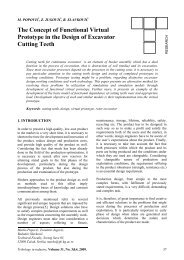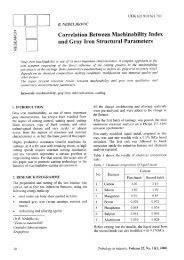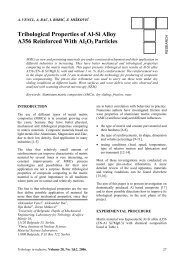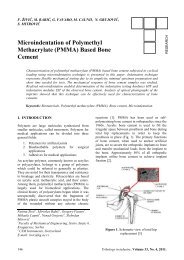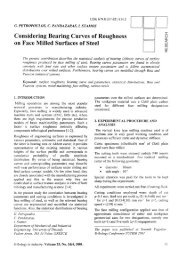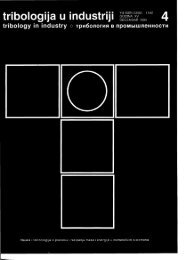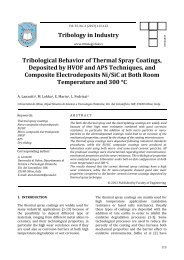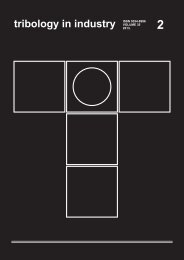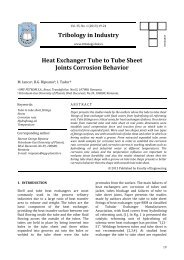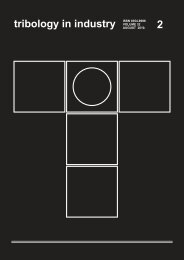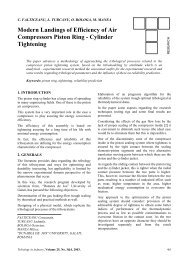No. 1, 1998 - Tribology in Industry
No. 1, 1998 - Tribology in Industry
No. 1, 1998 - Tribology in Industry
You also want an ePaper? Increase the reach of your titles
YUMPU automatically turns print PDFs into web optimized ePapers that Google loves.
at ciepth /r;<br />
b) the width 8211 of (2,/1) diffraction l<strong>in</strong>e correspond<strong>in</strong>g<br />
to lrirrtensits phase from case-ltarden<strong>in</strong>g steel (8211 is a<br />
size proporl ioirill to tetragonality degree, cia, of martensite<br />
phase;<br />
c) the rvidth 8220 of (220) diffrtrction l<strong>in</strong>e of ferrito-perlitic<br />
phase from steel (8226 is a size proportional to <strong>in</strong>ner<br />
second order tension, .t11 from crystall<strong>in</strong>e lattice);<br />
d) the ratio (l,,,<strong>in</strong>ll,rn) which is proportional to dislocation<br />
density,p, from crystall<strong>in</strong>e lattice (1,r,;, and I,nor) are<br />
respectively m<strong>in</strong>imum and maximumot Q20) diffraction<br />
l<strong>in</strong>e.<br />
Fig.2. Used tibonndel<br />
<strong>in</strong> accordance rvith SKF standarcl and it had the value<br />
1900 MPa, 3300 MPa, 4700 MPa. Dur<strong>in</strong>g the pitt<strong>in</strong>g test<br />
of up to 106 cvcles the l<strong>in</strong>ear-contact benveen triboelements<br />
were cont<strong>in</strong>uously lubricated with a special oil,<br />
ensur<strong>in</strong>g a thermostatic control ii c\0't- lnC.<br />
5. EVALUATION OF THE STR.UCTUITAL<br />
CHANGES, EXPERIMENTAL RESULTS.<br />
From all parameters of the surface layer, x;, i=1-6, only<br />
tension state, -rJ, and structure, -r5, have been studied.<br />
Thus, their distribLrtions (as value) over the depth, /r, of<br />
the surface laYer after pitt<strong>in</strong>g lcst were <strong>in</strong>vestigatecl. In<br />
this aim, the tested rollers u,ere electrochemically polished<br />
us<strong>in</strong>g a spccialii.' nranutactured <strong>in</strong>stallation.<br />
The chemical composition of the electrolyte was: II jPOa<br />
- 750 cnts; H2SCa-t8A on]; Croj-100g; H2O-280 rnl.<br />
Density of electric:tl cr.lrrent of electrolytic cell rvas l=0.7<br />
Alcrn2.Dur<strong>in</strong>g polish<strong>in</strong>g the sample (anocle) by means of<br />
an eng<strong>in</strong>e wris rotat<strong>in</strong>g rvith frec;rrency of 6.25 Hz. T'his<br />
motion assures lr homogeneity of both cclncentration and<br />
temperature of electrolytic bath. Also, a cool<strong>in</strong>g coil did<br />
not allow heat<strong>in</strong>g of the solution. By apply<strong>in</strong>g an electrolytic<br />
polish<strong>in</strong>g technique, lal,ers of 50tr<strong>in</strong>r thickness',vere<br />
successively rernoved from the tested triboelement.<br />
Alier eacl: polish<strong>in</strong>g, the tested roller was mounted on a<br />
X-ray diffraction equipment, type DP.ON-3 (XMoKe,<br />
tl=38kV, I:22 rrt4, .91=l mnt, Sz.=0.1p74). From the13<br />
andx5 parameters, have been evaiuated:<br />
a) relative percentage of residual austenite, YR(o/o),<br />
us<strong>in</strong>g the relation: VR(%) = ftul(a/o)]n*s [R4(%)]1,=0<br />
is the percentage of resiCual austenite at sample surface.<br />
IRA(%)]n*o is the si'rme size <strong>in</strong>sicle of the surface layer<br />
In figure -3 it is presented the depen



